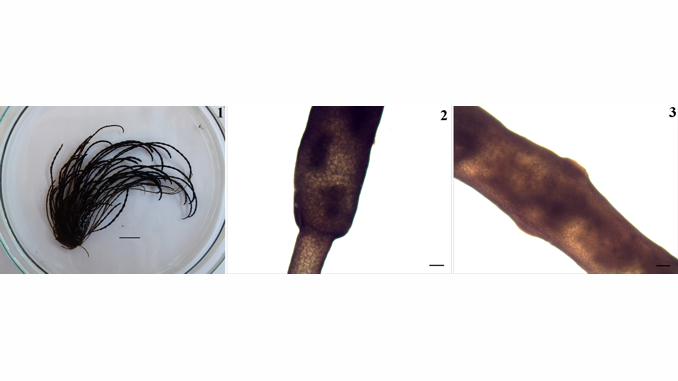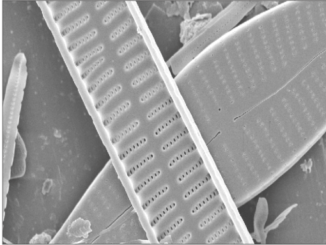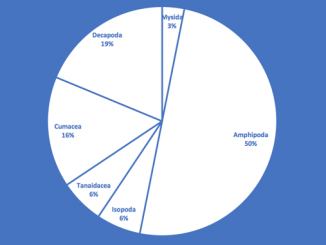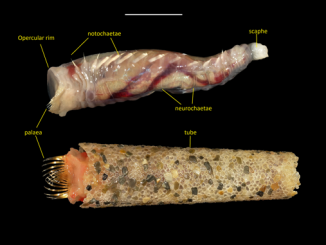
Paper category: Original research paper
Corresponding author: Aleksandra B. Mitrović (aleksandra.mitrovic@pmf.kg.ac.rs)
DOI: 10.2478/oandhs-2021-0006
Received: 18/05/2020
Accepted: 13/08/2020
Full text: here
Citation (APA style): Mitrović, A., Đorđević, N. & Simić, S. (2021). A review of research on the Lemanea genus in Serbia. Oceanological and Hydrobiological Studies, 50(1), 47-59. https://doi.org/10.2478/oandhs-2021-0006
Abstract
The first data on the Lemanea genus in Serbia come from the late 20th century. Only one species, L. fluviatilis, was reported from 10 localities in Serbian riverine ecosystems between 1991 and 2017. Extensive research on this genus was performed in April–November 2017–2019, surveying 150 localities in 97 upland and mountain rivers. During this study period, the Lemanea genus was recorded at 14 localities in 12 rivers, while it disappeared from five previously reported localities. A total of four taxa were identified: Lemanea fucina, L. rigida, Lemanea sp. and
L. fluviatilis. Lemanea fucina and L. rigida were recorded in Serbia for the first time. L. fluviatilis was the most common taxon. Our research confirmed that Lemanea species prefer similar specific environmental conditions. These species were found in temperate, soft or moderately hard, well-oxygenated and weakly alkaline waters, with low, moderate or high conductivity, and in waters with low content of inorganic nutrients. Due to their sensitivity to changes in environmental conditions, Lemanea species are exposed to negative anthropogenic impact leading to the degradation of their habitats. Intensive construction of small hydropower plants has threatened most habitats of the Rhodophyta species in the last few years.
Acknowledgements
The authors would like to thank the colleagues who assisted with sampling and the Scientific Research Society of Biology and Ecology Students “Josif Pančić”, which made field research possible. We would also like to thank the reviewers for their comments and constructive and helpful suggestions. This work was supported by the Serbian Ministry of Education, Science and Technological Development (Agreement No. 451-03-68/2020-14/200122).
References
American Public Health Association. (1995). Standard methods for examination of Water and Wastewater, 19th ed.. Washington, DC: Port City Press.
Berga, L. (2016). The role of hydropower in climate change mitigation and adaptation: a review. Engineering 2: 313–318. DOI: 10.1016/J.ENG.2016.03.004.
Blagojević, A., Subakov Simić, G., Blaženčić, J., Ilić, M., Petrović, J. et al. (2017). First record of Paralemanea torulosa (Roth) Sheath & A.R. Sherwood and new findings of Lemanea fluviatilis (Linnaeus) C. Ag. and Hildenbrandia rivularis (Liebmann) J. Agardh (Rhodophyta) in Serbia. Botanica Serbica 41(1): 55–63. DOI: 10.5281/zenodo.454096.
Carmona, J.J. & Necchi, O.Jr. (2002). Taxonomy and distribution of Paralemanea (Lemaneaceae, Rhodophyta) in Central Mexico. Cryptogamie Algol. 23: 39–49. DOI: 10.1016/S0181-1568(02)85006-1.
Carmona, J.J., Bojorge, M. & Ramirez, R.R. (2013). Phenology of Paralemanea mexicana (Batrachospermales, Rhodophyta) in high-altitude stream in central Mexico. Phycol Res. 62: 86–93. DOI: 10.1111/pre.12042.
Caro-Borrero, A. & Carmona-Jiménez, J. (2016). Associations Between Macroinvertebrates and Paralemanea mexicana, an endemic freshwater red alga from a Mountain River in Central Mexico. Neotrop Entomol. 45(6): 665–674. DOI: 10.1007/s13744-016-0420-z.
Chemeris, E.V. & Bobrov, A.A. (2009). Records of Rhodophyta species in rivers of the upper Volga region and adjacent areas. Botanitsetskij Journal 94: 1568–1583.
Dell'Uomo, A. (1991). Use of benthic macroalgae for monitoringrivers in Italy. In B.A. Whitton, E. Rott & G. Friedrich (Eds), Use of algae for monitoring river (pp. 129–138). Innsbruck: Universität of Innsbruck, Institut für Botanik.
Eloranta, P. (2019). Freshwater red algae in Finland. Plant and Fungal Systematics 64(1): 4–51. DOI: 10.2478/pfs-2019-0006.
Eloranta, P. & Kwandrans, J. (1996). Distribution and ecology of freshwater red algae (Rhodophyta) in some central Finnish rivers. Nordic Journal of Botany 16: 107–117.
Eloranta, P. & Kwandrans, J. (2007). Freshwater red algae (Rhodophyta). Identification guide to European taxa, particularly to those in Finland. Finland: Norrlinia.
Eloranta, P., Kwandrans, J. & Kusel-Fetzmann, E. (2011). Rhodophyceae and Phaeophyceae. In B. Budel, G. Gartner, L. Krienitz, H.R. Preisig & M. Schagerl (Eds.), Freshwater flora of Central Europe (pp. 1–155). Heidelberg: Spectrum Akademischer Verlag.
Eloranta, P., Eloranta, A. & Perämäki, P. (2016). Intensive study of freshwater red algae (Rhodophyta) in Finland. Fottea 16(1): 122–132. DOI: 10.5507/fot.2015.025.
Fijko, R. & Zeleňáková, M. (2017). Impact of small hydropower plant on the biodiversity of the selected area. In 10th International Conference “Environmental Engineering”, 27–28 April 2017 (pp. 1–6). Lithuania: Vilnius Gediminas Technical University. DOI: 10.3846/enviro.2017.077.
Ganesan, E.K., West, J.A. & Necchi, O.Jr. (2018). A catalogue and bibliography of non-marine (freshwater and estuarine) Rhodophyta (red algae) in India. Phytotaxa 364(1): 1–48. DOI: 10.11646/phytotaxa.364.1.
Guiry, M.D. & Guiry G.M. (2020). AlgaeBase. World-wide electronic publication, National University of Ireland, Galway. Available from: http://algaebase.org (accessed 22 June 2020).
Hunđek, H., Žganec, K. & Pusch M.T. (2020). A review of hydropower dams in Southeast Europe – distribution, trends and availability of monitoring data using the example of a multinational Danube catchment subarea. Renewable and Sustainable Energy Reviews 117: 1–11. DOI: 10.1016/j.rser.2019.109434.
Hyvärinen, E., Juslén, A., Kemppainen, E., Udström, A. & Liukko, U-M. (Eds.) (2019). The 2019 Red List of Finnish Species. Ministry of the Environment & Finnish Environmental Institute. Helsinki. (In Finnish)
Kashta, L. & Miho, A. (2016). The more frequently occurring macroalgae in Albanian running waters, BSHN 21/2016: 31–40.
Kibler, K.M. & Tullos, D.D. (2013). Cumulative biophysical impact of small and large hydropower development in Nu River, China. Water Resources Research 49: 3104–3118. DOI: 10.1002/wrcr.20243.
Koletić, N., Alegro, A., Rimac, A., Vuković, N. & Šegota V. (2020). Catalogue of Croatian Freshwater Rhodophytes. Phytotaxa 434(2): 151–169. DOI: 10.11646/phytotaxa.434.2.2.
Komárek, J. (2013). Cyanoprokaryota 3. Teil: Heterocytous Genera. In B. Büdel, G. Gärtner, L. Krienitz & M. Schagerl (Eds), Süßwasserflora von Mitteleuropa 19/3 (pp. 1–1130). Heidelberg, Berlin: Springer Spektrum Verlag.
Komárek, J. & Anagnostidis, K. (1999). Cyanoprokaryota 1. Teil: Chroococcales. In H. Ettl, G. Gärtner, H. Heynig & D. Mollenhauer (Eds), Süßwasserflora von Mitteleuropa 19/1 (pp. 1–548). Heidelberg, Berlin: Spektrum Akademischer Verlag.
Komárek, J. & Anagnostidis, K. (2005). Cyanoprokaryota 2. Teil: Oscillatoriales - In B. Büdel, G. Gärtner, L. Krienitz & M. Schagerl (Eds), Süβwasserflora von Mitteleuropa 19/2 (pp. 1–759). Heidelberg: Elsevier.
Krammer, K. & Lange-Bertalot, H. (1986). Bacillariophyceae. 1. Teil: Naviculaceae. In H. Ettl, J. Gerloff, H. Heynig & D. Mollenhauer (Eds), Süsswasserflora von Mitteleuropa 2/1 (pp. 1–876). Jena: G. Fischer Verlag.
Krammer, K. & Lange-Bertalot, H. (1991). Bacillariophyceae. 4. Teil: Achnanthaceae. In H. Ettl, G. Gartner, J. Gerloff, H. Heynig & D. Mollenhauer (Eds), Süsswasserflora von Mitteleuropa 2/4 (pp. 1–437). Stuttgart: G. Fischer Verlag.
Kumano, S. (2002). Freshwater Red Algae of the World. Bristol: Biopress Ltd.
Kučera, P. & Marvan, P. (2004). Taxonomy and distribution of Lemanea and Paralemanea (Lemaneaceae, Rhodophyta) in the Czech Republic. Preslia 76:163–174.
Liermann, C.R., Nilsson, C., Robertson, J. & Ng, R.Y. (2012). Implications of dam obstruction for global freshwater fish diversity. BioScience 62: 539–548. DOI: 10.1525/BIO.2012.62.6.5.
Manzano-Agugliaro, F., Taher, M., Zapata-Sierra, A., Juaidi, A. & Montoya, F.G. (2017). An overview of research and energy evolution for small hydropower in Europe. Renewable and Sustainable Energy Reviews 75: 476–489. DOI: 10.1016/j.rser.2016.11.013.
Ministry of Mining and Energy of Republic of Serbia. Survey of small hydropower plants in Serbia. Available from: (http://mhe.mre.gov.rs/).
Necchi, O.Jr. & Moreira, J.C.L. (1995). Longitudinal distribution of macroalgae in two tropical lotic ecosystems from southeastern Brazil. Arch Hydrobiol. 135: 113–128.
Institute for Nature Conservation of Serbia. (5/2010, 47/2011, 32/2016, 98/2016). Code on declaration and protection of strictly protected and protected wild species of plants, animals and fungi. Serbia: Official Gazette of the Republic of Serbia.
Ramirez-Rodriguez, R., Carmona, J. & Martorell, C. (2007). Microhabitat and morphometric variation in two species of Prasiola (Prasiolales, Chlorophyta) from stream in central Mexico. Aquat Ecol. 41: 161–168. DOI: 10.1007/s10452-006-9068-9.
Ristić, R., Malušević, I., Polovina, S., Milčanović, V. & Radić, B. (2018). Small hydropower plants – derivation type: insignificant energy benefit and immeasurable environmental damage. Vodoprivreda 50(294–296): 311–317. (English summary)
Schwarz, U. (2019). Hydropower pressure on European rivers: The story in numbers. For FLUVIUS, WWF, RiverWatch, EuroNatur & GEOTA.
Siemińska, J. (1992). List of threatened plants in Poland (2nd edition). In K. Zarzycky, W. Wojewoda & Z. Heinrich (Eds), List of threatened plants in Poland (pp. 7–19). Poland: Polish Academy of Sciences, W. Szafer Institute of Botany.
Simić, S. (1995). Benthic algae communities of the Trgoviški Timok. Master's thesis, University of Belgrade, Belgrade, Serbia. (In Serbian).
Simić, S. (2002). Macroalgae in streams of hill-mountain areas of Serbia. Doctoral dissertation, University of Belgrade, Belgrade, Serbia. (In Serbian).
Simić, S. (2007). Morphological and ecological characteristics of rare and endangered species Lemanea fluviatilis (L.) C. Ag. (Lemaneaceae, Rhodophyta) on new localities in Serbia. Krag. J. Sci. 29: 97–106.
Simić, S. & Ranković, B. (1998). New data on the distribution, morphology and ecology of red algae (Rhodophyta) in rivers of Serbia. Arch. Biol. Sci. 50(1): 43–50.
Simić, S. & Djordjević, N. (2011). Lemanea fucina Bory, 1808 (Lemaneaceae, Rhodophyta), a rare species with a variable morphology: first record in the Republic of Montenegro. Arch. Biol. Sci. 63(2): 511–515. DOI: 10.2298/ABS1102511S.
Simić, S.B. & Đorđević, N.B. (2017). Morphology, distribution and ecology of the freshwater red algae Paralemanea (Batrachospermaceae, Batrachospermales, Rhodophyta) in Serbia. Arch. Biol. Sci. 69(1): 167–174. DOI: 10.2298/ABS160211093S.
Simić, S., Pantović, N. & Vasiljević, B. (2010). Factors threatening the habitats of rare species of Rhodophyta in Serbia. In Conference on water observation and information system for decision suport, Balwois, 25–29 May 2010 (pp. 440–451). Republic of Macedonia, Ohrid: University St. Kliment Ohridski, Hydrobiological Institute Naum.
Simić, B.S., Đorđević B.N. & Mitrović, B.A. (2019). Review of the research on red algae (Rhodophyta) in freshwater ecosystems in Montenegro. International Conference “Adriatic Biodiversity Protection”, 07–11 April 2019 (p. 113). Montenegro, Kotor: University of Montenegro, Institute of Marine Biology.
Temniskova, D., Stoyneva, P.M. & Kirjakov, K.I. (2008). Red List of the Bulgarian algae. I Macroalgae. Phytol Balc. 14(2): 193–206.
Vis, L. & Sheath, R.G. (1992). Systematics of the freshwater red algal family Lemaneaceae in North America. Phycologia 31(2): 164–179. DOI: 10.2216/i0031-8884-31-2-164.1.
Wehr, J.D. & Sheath, RG. (2003). Freshwater Algae of North America Ecology and Classification. USA: Academic Press.
Wiatkowski, M. & Tomczyk, P. (2018). Comparative assessment of the hydromorphological status of the rivers Odra, Bystrzyca, and sleza using the RHS, LAWA, QBR, and HEM methods above and below the hydropower plants. Water 10: 1–16. DOI: 10.3390/w10070855.
Wu, N.C., Jiang, W.X., Fu, X.C., Zhou, S.C., Li, F.Q. et al. (2010). Temporal impacts of a small hydropower plant on benthic algal community. Fundam. Appl. Limnol. 177(4): 257–266. DOI: 10.1127/1863-9135/2010/0177-0257.



